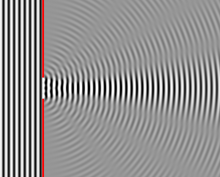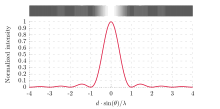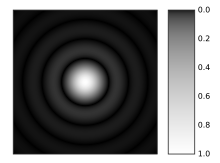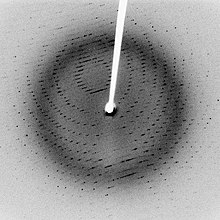Difracción
Diffraction is a term attributed to various phenomena that occur when a wave meets an obstacle or slit. It is defined as the deflection of waves around the corners of an obstacle or through the opening in the region of a geometric shadow of the obstacle. The diffracting object or slit effectively becomes a secondary source of the propagating wave. Italian scientist Francesco Maria Grimaldi coined the word "diffraction" and he was the first to record precise observations of the phenomenon in 1660.
In classical physics, the phenomenon of diffraction is described by the Fresnel - Huygens Principle which treats each point in the front of a propagating wave as a group of individual spherical wavelets. The characteristic interference pattern is most marked when a wave from a coherent source (such as a laser) is at a slit/gap that is comparable in size to its wavelength, as shown in the inset image. This is due to the addition, or interference, of different points on the wavefront (or, equivalently, of each wavelet) traveling by paths of different lengths to the recording surface. However, if they are multiple openings in close proximity, they can result in a complex pattern of varying intensity.
These effects also occur when a light wave travels through a medium with a variable Index of Refraction, or when a sound wave travels through a medium with variable acoustic impedance – all waves are diffracted, including waves gravitational waves [citation needed], water waves, and other electromagnetic waves like X-rays and radio waves. In addition, quantum mechanics also shows that mass possesses matter waves, and therefore undergoes diffraction (which is measurable from subatomic to molecular levels).
Diffraction and interference are closely related and are almost – if not exactly – identical in meaning. Richard Feynman observes that "diffraction" tends to be used when referring to many wave sources, and "interference" when only a few are considered.
History
The effects of light diffraction were first carefully observed and described by Francesco Maria Grimaldi, who also coined the term diffraction, from the Latin diffringere, & 'break into pieces', referring to the splitting of light in different directions. The results of Grimaldi's observations were published after his death in 1665. Isaac Newton studied these effects and attributed them to the bending of light rays. James Gregory (1638–1675) observed that diffraction patterns caused by a bird's feather were indeed the first diffraction grating to be discovered. Thomas Young performed an experiment demonstrating the interference of two closely spaced slits in 1803. Explaining the results of the interference of waves emanating from two different slits, he deduced that light must propagate as waves. Augustin-Jean Fresnel made more definitive studies and calculations of diffraction, made public in 1816 and 1818, and thereby gave great support to the wave theory of light that had been promoted by Christiaan Huygens and revitalized by Young, against Newton's particle theory.
Mechanism
In classical physics, diffraction occurs because of the way waves propagate; this is described by the Fresnel-Huygens principle and the wave superposition principle. The propagation of a wave can be visualized considering each particle of the medium transmitted in a wavefront as a source point of a secondary spherical wave. The wave displacement at any subsequent point is the sum of these secondary waves. When waves add, the addition is determined by the relative phases as well as the amplitudes of the individual waves so that the summed amplitude of the waves can have any value between zero and the sum of the individual amplitudes. Therefore, diffraction patterns normally have a series of maxima and minima.
According to the modern quantum mechanical explanation of the propagation of light through a slit (or slits), each photon is characterized by what is known as a wave function, which describes the path the photon follows from the emitting source, through the slit and to the screen. The trajectory is determined by both the physical environment and the slit geometry, the distance from the screen, and the initial conditions when the photon is created. The existence of the photon wave function was demonstrated in several experiments, such as the one carried out by Geoffrey Ingram Taylor in 1909 (see Young's experiment). In the quantum perspective the diffraction pattern is created by the trajectory distribution. The presence of light and dark bands is due to the presence or absence of photons in these areas. This approach has some striking similarities to the Fresnel-Huygens principle; according to which each slit acts as a secondary source of light, giving rise to different paths for the photons to pass through the slits.
There are several analytical models that allow the diffracted field to be calculated, including the Kirchhoff-Fresnel diffraction equation which is derived from the wave equation, the Fraunhofer diffraction approximation of the Kirchhoff equation which is applied to the far field and to Fresnel diffraction, an approximation that applies to the near field. Most models cannot be solved analytically, but numerical solutions can be provided through finite element and limit element methods.
It is possible to gain a qualitative understanding of many diffraction phenomena by considering how the relative phases of individual secondary wave sources vary, and in particular the conditions where the phase shift is equal to half a cycle, in which case the waves they will cancel each other.
The simplest descriptions of diffraction are those in which the problem can be reduced to a two-dimensional one. For water waves, this is already the case; these propagate only on the surface of the water. For light, we can often forget a direction if the diffractive object propagates in that direction over a distance much greater than the wavelength. In the case where light shines through small circular holes, we will take into account the full three-dimensional nature of the problem.
Examples
The effects of diffraction are often seen in everyday life. The most striking examples of diffraction are those that involve light; for example, the closely spaced tracks on a CD or DVD that act as a diffraction grating to form the common rainbow pattern seen when looking at a disc. This principle can be used to design a grating with a structure that can produce any desired pattern of diffraction; The hologram on a credit card is an example. Diffraction in the atmosphere due to small particles can cause a glowing ring to be seen around a bright light source such as the Sun or Moon. The shadow of a solid object, using light from a compact source, shows small fringes near its edges. The splotchy pattern seen when laser light falls on an optically rough surface is also a diffraction phenomenon. When deli meat appears to be iridescent, that is, diffraction from meat fibers. All these effects are a consequence of the fact that light propagates as a wave.
Diffraction can happen with any kind of wave. Ocean waves are diffracted around piers and some other obstacles. Sound waves can be diffracted around objects, so you can still hear someone calling even when that person is hiding behind a tree. Diffraction may also be a consideration in some technical applications; since it establishes a fundamental limit for the resolution of a camera, telescope or microscope.
Here are other examples of diffraction.
Diffraction through a slit
A long slit of infinitesimal width that is illuminated by light, diffracts it into a series of circular waves, and the wavefront emerging from the slit is a cylindrical wave of uniform intensity, according to the Huygens-Fresnel principle.
A slit that is wider than the wavelength produces interference effects in the space downstream of the slit. This can be explained by assuming that the slit behaves as if it had a large number of point sources evenly spaced across the width of the slit. The analysis of this system is simplified if we consider light of a single wavelength. If the incident light is coherent, all these sources happen to have the same phase. The light at a given point in the space downstream of the slit is composed of contributions from each of these point sources, and if the relative phases of these contributions vary by 2π or more, we can expect to find minima and maxima in the diffracted light. These offsets are caused by differences in the path lengths over which the contributing rays reach the point from the slot.
We can find the angle in which a first minimum will be obtained in the diffracted light by the following reasoning. The light of a source located on the upper edge of the slit interferes destructively with a source located in the middle of the slit, when the difference of trajectory between them is equal to λ / 2. Similarly, the source just below the top of the slot will interfere destructively with the source located just below the middle of the slot at the same angle. We can continue this reasoning throughout the height of the cleft to conclude that the condition of destructive interference for all the cleft is the same as the condition of destructive interference between two narrow clefts at a distance of half the width of the cleft. The trajectory difference is approximately dwithout (θ θ )2{displaystyle {frac {dsin(theta)}{2}}}}} for minimum intensity to occur at an angle θ min defined by:
- dwithout θ θ min=λ λ {displaystyle d,sin theta _{text{min}}}=lambda }
where:
- d is the width of the slot,
- θ θ min{displaystyle theta _{text{min}}}} is the incidence angle that occurs at the minimum intensity, and
- λ λ {displaystyle lambda } is the wavelength of light.
A similar argument can be used to indicate that if we imagine the slit to be divided into four, six, eight parts, etc., the minima are obtained at angles θ n given by
- dsen θ θ n=nλ λ {displaystyle d,operatorname {sen} theta _{n}=nlambda }
where:
- n It's a different whole number from zero.
There is no such simple argument that allows us to define the maxima of the diffraction pattern. The intensity profile is calculated using the Fraunhofer diffraction equation as
- I(θ θ )=I0sinc2 (dπ π λ λ without θ θ ){displaystyle I(theta)=I_{0}operatorname {sinc} ^{2}left({frac {dpi }{lambda }}}sin theta right)}}
where:
- I(θ θ ){displaystyle I(theta)} is the intensity at a given angle,
- I0{displaystyle I_{0}} is the original intensity, and
- The previous non-standardized sinc function is given by sinc (x)=without xx{displaystyle operatorname {sinc} (x)={frac {sin x}{x}}}}} for xI was. I was. 0{displaystyle xneq 0} and sinc (0)=1{displaystyle operatorname {sinc} (0)=1}
This analysis applies only to the far-field approximation, that is, at a distance greater than the slit width.
From the intensity profile above, yes d.. λ λ {displaystyle dll lambda }, the intensity will be undependent θ θ {displaystyle theta }, then, the wave front that originates from the slot would look like a cylindrical wave of uniform intensity; d λ λ {displaystyle dgg lambda }alone θ θ ≈ ≈ 0{displaystyle theta approx 0} it would have a significant intensity, so the wave front that originates from the slot would be similar to that of the geometric optics.
Diffraction grating
A grating is an optical component with a regular pattern. The shape of the light diffracted by a grating depends on the structure of the elements and the number of elements present, but every grating has intensity maxima at the angles θm which are given by the equation of the grid.
- d(without θ θ m+without θ θ i)=mλ λ .{displaystyle dleft(sin {theta _{m}}}+sin {theta _{i}}}}right)=mlambda. !
where:
- θi is the angle in which the light incides,
- d is the separation of the elements of the network, and
- m is an integer that can be positive or negative.
The light diffracted by a grating can be determined as the sum of the light diffracted at each grating element, and is essentially a convolution of diffraction and interference patterns.
The figure shows the light diffracted by the 2 and 5 element lattice where the distances between the slits are equal; it can be seen that the maxima are in the same position, but the detailed structures of the intensities are different.
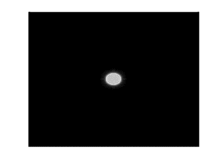
Circular opening
Far-field diffraction of a plane wave incident on a circular aperture is often known as the Airy Disc. The variation of the intensity with respect to the angle is given by:
- I(θ θ )=I0(2J1(kawithout θ θ )kawithout θ θ )2{displaystyle I(theta)=I_{0}left({frac {2J_{1}(kasin theta)}{kasin theta }}right)^{2}
where:
- a is the radius of the circular opening,
- k equals 2π/λ,
- J1 It's Bessel's Function. The lower the opening, the greater the size of the point at a determined distance and the greater the divergence of the diffracted rays.
General opening
The wave that emerges from a punctual source has a amplitude END END {displaystyle psi } in r{displaystyle mathbf {r} } which is given by the solution of the wave equation in the frequency domain for a punctual source (Helmholtz equation),
- ► ► 2END END +k2END END =δ δ (r){displaystyle nabla ^{2}psi +k^{2}psi =delta (mathbf {r}}}}}
Where δ δ (r){displaystyle delta (mathbf {r}}}} is the three-dimensional delta function. The delta function only has radial dependence, so the Laplace Operator (a.k.a. climbing Laplaciano) in the spherical coordinate system simplifies to (cylindrical and spherical coordinates),
- ► ► 2END END =1r▪ ▪ 2▪ ▪ r2(rEND END ){displaystyle nabla ^{2}psi ={frac {1}{r}}{frac {partial ^{2}}{partial r^{2}}}}{psi)}
By direct substitution, the solution of this equation can easily be demonstrated that it is the scale of the function of Green, that in the system of spherical coordinate (and using the time convention of physics e− − iω ω t{displaystyle e^{-iomega t}) is:
- END END (r)=eikr4π π r{displaystyle psi (r)={frac {e^{ikr}}{4pi r}}}}
This solution means that the source of the delta function is at the origin. If the source is at an arbitrary point of origin, denoted by the vector r♫{displaystyle mathbf {r}and the field point is located at the point r{displaystyle mathbf {r} }, then we can represent the scale of the function of Green (for the location of the arbitrary source) as:
- END END (r日本語r♫)=eik日本語r− − r♫日本語4π π 日本語r− − r♫日本語{displaystyle psi (mathbf {r} ⋅mathbf {r} ')={frac {e^{ik ultimatebf {r} -mathbf {r}{r}}}{mathbf}{r}}{mathbf {r}}}}{mathbf}}}}}}}{mathbf}{mathbf} {r}}
Therefore, if an electric field, Einc(x,y) is incident on the opening, the field produced by this distribution of the opening is given by the surface integral:
- (r) ∫ ∫ apertureEinc(x♫,and♫)eik日本語r− − r♫日本語4π π 日本語r− − r♫日本語dx♫dand♫,{displaystyle Psi (r)propto iint limits _{mathrm {aperture} }E_{mathrm {inc} }(x',y')~{frac {e^{ik implicamathbf {r} -mathbf {r}{cd}}}{4pi Δmathbf {r} -mathbf {r}}},dx',dy'}}
Where the point of origin at the aperture is given by the vector
- r♫=x♫x^ ^ +and♫and^ ^ {displaystyle mathbf {r} '=x'mathbf {hat {x} +y'mathbf {hat {y}}} }
In the far field, where the parallel-rays approximation can be used, the Green function,
- END END (r日本語r♫)=eik日本語r− − r♫日本語4π π 日本語r− − r♫日本語{displaystyle psi (mathbf {r} ⋅mathbf {r} ')={frac {e^{ik ultimatebf {r} -mathbf {r}{r}}}{mathbf}{r}}{mathbf {r}}}}{mathbf}}}}}}}{mathbf}{mathbf} {r}}
Simplifies to
- END END (r日本語r♫)=eikr4π π re− − ik(r♫⋅ ⋅ r^ ^ ){displaystyle psi (mathbf {r} ⋅mathbf {r} ')={frac {e^{ikr}}{4pi r}}e^{-ik(mathbf {r}cdot mathbf {r}}}}}}}}} !
as can be seen in the figure on the right (click to enlarge).
The expression for the far zone field (Fraunhofer region) becomes
- (r) eikr4π π r∫ ∫ apertureEinc(x♫,and♫)e− − ik(r♫⋅ ⋅ r^ ^ )dx♫dand♫,{displaystyle Psi (r)propto {frac {e^{ikr}}{4pi r}}{iint limits _{mathrm {aperture} }E_{mathrm {inc} }(x,y')e^{-ik(mathbf {r} 'cdot mathbf {hat {r}}}}}},dx',dy',}
Now, since
- r♫=x♫x^ ^ +and♫and^ ^ {displaystyle mathbf {r} '=x'mathbf {hat {x} +y'mathbf {hat {y}}} }
and
- r^ ^ =without θ θ # φ φ x^ ^ +without θ θ without φ φ and^ ^ +# θ θ z^ ^ {displaystyle mathbf {hat {r}} =sin theta cos phi mathbf {hat {x}} +sin theta ~sin phi ~mathbf {hat {y}}} +cos theta mathbf {hat {z}} }
the expression for the Fraunhofer region field of a plane aperture becomes,
- (r) eikr4π π r∫ ∫ apertureEinc(x♫,and♫)e− − ikwithout θ θ (# φ φ x♫+without φ φ and♫)dx♫dand♫{displaystyle Psi (r)propto {frac {e^{ikr}}{4pi r}}{iint limits _{mathrm {aperture} E_{mathrm {inc} }(x',y')e^{-iksin theta (cos phi x'+sin phi y')},dx',dy'}
Being,
- kx=kwithout θ θ # φ φ {displaystyle k_{x}=ksin theta cos phi ,!}
and
- kand=kwithout θ θ without φ φ {displaystyle k_{y}=ksin theta sin phi ,!}
the field in the Fraunhofer region of the plane aperture assumes the form of a Fourier transform
- (r) eikr4π π r∫ ∫ apertureEinc(x♫,and♫)e− − i(kxx♫+kandand♫)dx♫dand♫,{displaystyle Psi (r)propto {frac {e^{ikr}}{4pi r}}{iint limits _{mathrm {aperture} E_{mathrm {inc} }(x',y')e^{-i(k_{x}x'+k_{y}y')},dx',dy',}
In the far field / Fraunhofer region, this becomes the spatial Fourier transform of the aperture distribution. Huygens' principle, when applied to an aperture, simply says that the far-field diffraction pattern is the spatial Fourier transform of the shape of the aperture, and this is a direct byproduct of using the parallel-ray approximation, which is identical to doing a plane wave decomposition of the plane fields of the aperture (see Fourier optics).
Propagation of a laser beam
The way the profile of a laser beam changes as it propagates is determined by diffraction. When the entire emitted beam has a flat and spatially coherent wavefront, it approximates the Gaussian beam profile and has the least divergence for a given diameter. The smaller the production beam, the faster it diverges. The smaller the output beam, the faster it deflects. It is possible to reduce the divergence of a laser beam by first expanding it with a convex lens and then collimating it with a second convex lens whose focal point coincides with that of the first lens. The resulting ray has a larger diameter, and therefore less divergence. The divergence of a laser beam can be reduced below the diffraction of a Gaussian beam or even reversed to convergence if the refractive index of the propagating medium increases with the intensity of light. This can lead to an autofocus effect..
When the wavefront of the emitted beam is perturbed, only the transverse coherence length (where the perturbation of the wavefront is less than 1/4 of the wavelength) should be considered as a Gaussian beam diameter when determining the divergence of the laser beam. If the transverse coherence length in the vertical direction is greater than in the horizontal, the divergence of the laser beam will be less in the vertical than in the horizontal direction.
Diffraction Limited Imaging
The ability of an imaging system to resolve detail is ultimately limited by diffraction. This is because a plane wave incident on a circular lens or mirror is diffracted as described above. The light is not focused to a point but forms an Airy Disc that has a center point in the focal plane with a first zero radius of
- d=1.22λ λ N,{displaystyle d=1.22lambda N,,}
where λ is the wavelength of light and N is the f-number (focal length divided by diameter) of the imaging optics. In the space of objects the corresponding angular resolution is
- without θ θ =1.22λ λ D,{displaystyle sin theta =1.22{frac {lambda }{D}},,}
where D is the diameter of the entrance pupil of the imaging lens (for example, the main mirror of a telescope).
Two point sources will each produce an Airy pattern — see the photo of a binary star. As the point sources get closer to each other, the patterns will begin to overlap, eventually merging to form a single pattern, in which case the two point sources cannot be resolved in the image. The Rayleigh criterion specifies that two point sources can be considered resolvable if the separation of the two images is at least the radius of the Airy disk, that is, if the first minimum of one coincides with the maximum of the other.
Thus, the larger the aperture of the lens, and the smaller the wavelength, the finer the resolution of an imaging system. This is why telescopes have very large lenses or mirrors, and why light microscopes are limited in the detail they can see.
Spot Patterns
The splotchy pattern you see when using a laser pointer is another diffraction phenomenon. It is the result of the superposition of many waves with different phases, which are produced when a laser beam illuminates a rough surface. They add up to give a resultant wave whose amplitude, and therefore intensity, varies randomly.
Babinet's Principle
Babinet's principle is a useful theorem that states that the diffraction pattern from an opaque body is identical to that from a hole of the same size and shape, but with different intensities. This means that the interference conditions of a single obstruction would be the same as those of a single slit.
Patterns
Several qualitative observations can be made about diffraction in general:
- The angular spacing of the traits in the pattern of defaction is inversely proportional to the dimensions of the object causing defaction. In other words: The smaller the defatant object, the more "amplio" is the resulting defaction pattern, and vice versa. (More precisely, this is true for the sinuses of the angles.)
- Diffraction angles are invariable low-scale; that is, they depend only on the relationship between the wavelength and the size of the defractor object.
- When the defatant object has a periodic structure, for example, in a defraction grid, the characteristics generally become sharper. The third figure, for example, shows a comparison of a double fold pattern with a pattern formed by five slits, both sets of slits have the same space, between the center of a slit and the next.
Particle diffraction
Quantum theory tells us that every particle exhibits wave properties. In particular, massive particles can interfere with themselves and thus diffract. The diffraction of electrons and neutrons was one of the powerful arguments in favor of quantum mechanics. The wavelength associated with a particle is the de Broglie wavelength.
- λ λ =hp{displaystyle lambda ={frac {h}{p}},}
Where h is Planck's constant and p is the momentum of the particle (mass × velocity for slow moving particles).
For most macroscopic objects, this wavelength is so short that it doesn't make sense to assign a wavelength to it. A sodium atom traveling at about 30,000 m/s would have a de Broglie wavelength of about 50 picometers.
Because the wavelength for even the smallest of macroscopic objects is extremely small, diffraction of matter waves is only visible to tiny particles, such as electrons, neutrons, atoms, and small molecules. The short wavelength of these matter waves makes them ideal for studying the atomic crystal structure of solids and macromolecules such as proteins.
Bragg diffraction
Diffraction of a three-dimensional periodic structure like atoms in a crystal is called Bragg diffraction. It is similar to what happens when waves in a diffraction grating are scattered. Bragg diffraction is a consequence of interference between waves that are reflected from different crystal planes. The constructive interference condition is given by Bragg's law:
- mλ λ =2dwithout θ θ {displaystyle mlambda =2dsin theta ,}
where:
- λ It's the wavelength,
- d is the distance between the glass planes,
- θ is the angle of the diffracted wave,
- m It is an integer known as the order of the diffracted beam.
Bragg diffraction is observed with either very short-wavelength electromagnetic radiation such as X-rays or matter waves such as neutrons and electrons whose wavelength is on the order of atomic spacing or much less. The pattern produced gives information on the separations of the crystallographic planes d, allowing the deduction of the crystalline structure. Diffraction contrast, in electron microscopes and x-topography devices in particular, is also a powerful tool for examining individual defects and local stress fields in crystals.
Consistency
The description of diffraction is based on the interference of waves emanating from the same source and taking different paths to the same point on a screen. In this description, the phase difference between waves that took different paths only depends on the effective length of the path. This does not take into account the fact that the waves arriving on the screen at the same time were emitted by the source at different times. The initial phase with which the source emits waves can change over time in unpredictable ways. This means that the waves emitted by the source, sometimes too far apart, can no longer form a constant interference pattern, since the relationship between their phases is no longer independent of time.
The length with which the phase in a ray of light is correlated is called the coherence length. For interference to occur, the path length difference must be less than the coherence length. This is sometimes called spectral coherence, since it is related to the presence of different frequency components in the wave. In the case of light emitted by an atomic transition, the duration of coherence is related to the lifetime of the excited state from which the atom made its transition.
If waves are emitted from an extended source, this can lead to incoherence in the transverse direction. When looking at a cross section of a ray of light, the length over which the phase is correlated is called the transverse coherence length. In the case of Young's double slit experiment, this would mean that if the transverse coherence length is less than the gap between the two slits, the resulting pattern on a screen would resemble two diffraction patterns. single slit.
In the case of particles such as electrons, neutrons, and atoms, the coherence length is related to the spatial extent of the wave function that the particle describes.
Contenido relacionado
Asynchronous transfer mode
Aerospace engineering
Alternator






